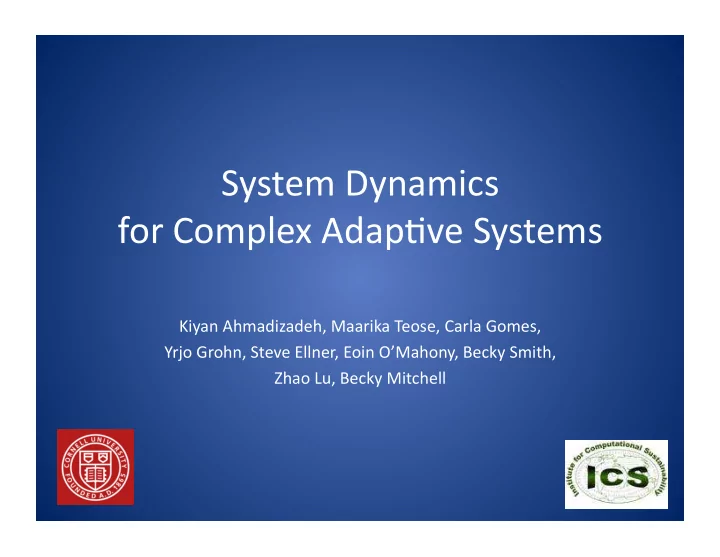

System Dynamics for Complex Adap6ve Systems Kiyan Ahmadizadeh, Maarika Teose, Carla Gomes, Yrjo Grohn, Steve Ellner, Eoin O’Mahony, Becky Smith, Zhao Lu, Becky Mitchell
Outline • Complex Adap6ve Systems • Modeling paradigms – System Dynamics • Popula6on Growth • Epidemiology – Agent‐based Modeling – Strengths/weaknesses of each • Embedded (Hybrid) Models
Complex Adap6ve Systems “The whole is not only more than but very different than the sum of its parts.” ( Anderson, Phil W. 1972. “More is Different.” Science 177: 393‐96) • Dynamic network of many agents (e.g. cells, species, individuals, firms, na6ons) ac6ng in parallel, constantly ac6ng and reac6ng to what the other agents are doing • Control of CAS is dispersed, decentralized • Emergent behaviors (e.g. equilibria, pa`erns) arise from compe66on and coopera6on among agents System behavior is unpredictable and the result of decisions made every moment by many individual agents
Complex Adap6ve Systems • Examples: – Energy grids – Ecosystems – Social diffusion – Disease dynamics – Poli6cs – Supply chain networks – Etc. ecosystems.noaa.gov caida.org Computa<onal Sustainability seeks to model the CAS of ornl.gov our world in the hopes of guiding them toward long‐ term, sustainable outcomes
Modeling CAS • Two basic approaches: – Top‐down: System Dynamics • ODEs, Stock and Flow Diagrams – Bo`om‐up: Agent‐based Modeling • Cellular Automata, Intelligent Agents
System Dynamics Feedback Loops: Stocks: State Variables Flows: Rates of Change Nonlinear Interac6ons
System Dynamics • Flows can be of three types: – Genera6ve ( F gen ) – Stock‐to‐Stock ( F in , F out ) – Destruc6ve ( F des )
System Dynamics • Discrete systems: – Stocks: homogenous groups of well‐mixed agents – Flows: movement of agents between groups – Feedback Loops: nonlinear interac6ons and effects • r 2 = f(X,Y)
System Dynamics • Example 1: Popula6on Growth • P – popula6on size at 6me t • r – growth rate • K – habitat carrying capacity – Exponen6al growth when popula6on is small – Exponen6al decay when popula6on above K
Popula6on Growth
Popula6on Growth
Popula6on Growth: Delayed Maturity
Popula6on Growth: Delayed Maturity and Consump6on
System Dynamics • Example 2: Infec6ous Disease • S – Suscep6ble popula6on • I – Infec6ous popula6on • R – Recovered popula6on • β – Transmission rate • γ – Recovery rate
Infec6ous Disease
Infec6ous Disease
System Dynamics • Simula6on – For most systems of ODEs, analy6cal solu6ons do not exist – Con6nuous stock (e.g. money in savings): use numerical methods to approximate solu6on – Discrete stock (e.g. people): use stochas6c simula6on methods
Stochas6c Simula6on of ODEs • Assump6on: Future state of system depends only on present state, independent of history Con6nuous Time Markov Chain! – Time between events Exponen6ally distributed – Event occurrences in [ t, t+Δt ) Poisson distributed
Stochas6c Simula6on of ODEs • ODEs as CTMCs – Flows are interpreted as transi6on probabili6es per unit 6me – Events: • { X X+1 } ~ Pois ( r 1 Δt ) • { (X,Y) (X‐1,Y+1)} ~ Pois ( r 2 Δt ) • { Y Y‐1 } ~ Pois ( r 3 Δt ) – For Δt small, probability of more than one event per 6me step is o( Δt 2 ), negligible
Stochas6c Simula6on of ODEs
System Dynamics • Strengths: – Easy model construc6on and valida6on with available data – Simula6on methods computa6onally efficient • Weaknesses: – Assumes homogenous and well‐mixed popula6on – Captures only average behavior – Assumes mathema6cal equa6ons capture all feedback structure in system – Assumes macro‐level behavior is independent of micro‐ level behavior – Difficult to model certain interven6ons (ac6ons by outsiders) that influence flows in the model
Agent‐Based Modeling • System modeled as popula6on of heterogeneous agents with evolving state space (e.g. Schelling Segrega6on Model) • Agent interac6ons can cause complex emergent behavior to arise • Object‐oriented programming well‐suited for represen6ng interac6ng agents www.marginalrevolu6on.com
Agent‐Based Modeling • Example: EpiSims – Highly detailed – Virtual laboratory www.sciam.com www.sciam.com
Agent‐Based Modeling • Strengths: – Allows sophis6cated interac6ons between agents with heterogeneous state space (e.g. contact network) – Yields greater and more intui6ve informa6on that can be used by researchers and policymakers – More “lifelike” than system dynamics models • Weaknesses: – larger state space means poor computa6onal efficiency – Model construc6on is difficult: hard to link observed behavior to local interac6ons, capture all cri6cal feedback loops – Model calibra6on, valida6on, and sensi6vity analysis require large amounts of data and 6me
Embedded (Hybrid) Models • A complete agent‐based model need not be fi`ed, but individual‐level granularity in the model is maintained and heterogeneity in agents can be exploited • Allows for simula6on of novel, complex interven6on strategies at the level of agents that might otherwise be difficult or impossible to express succinctly in system dynamics terminology
Recommend
More recommend